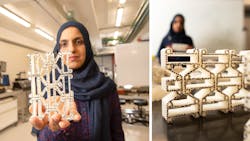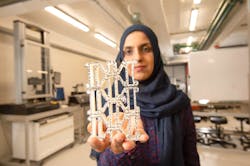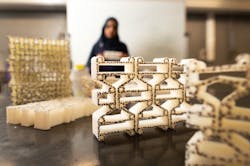What Do Running Shoes, Memory Foam and Masonry Have in Common?
On the surface, running shoes, memory foam and masonry don’t have much in common. But there is a new material connection.
Auxetic materials are used in running shoes and memory foam. Researchers are now investigating the design properties of auxetics in the construction of novel applications, such as masonry.
Using off-the-shelf bioplastic to 3D print geometric shapes that mimic the behavior of auxetic materials, a Queensland University of Technology researcher has developed a material that can potentially protect buildings from collision damage and other high-impact forces, equivalent to a car travelling at 37.28 mph.
Under a tensile force applied in longitudinal direction, auxetics expand in the perpendicular transverse direction. In other words, instead of flattening when stretched, or distending when compressed, auxetics expand or contract in all directions, making them useful in specific applications.
This property makes auxetic materials highly energy-absorbent and load resistant, said Dr. Tatheer Zahra, a researcher from the QUT Centre for Materials Science and QUT School of Civil and Environmental Engineering. The paper is published in Smart Materials and Structures.
Since existing commercial auxetic material is expensive and not locally available, the researcher designed geometric shapes that achieved the same behavior. She said 3D printing auxetic geometries could potentially replace steel- and fiber-reinforced polymer mesh reinforcements in composites, and could also be used as a flexible and widely applicable protective wall render.
Zahra estimated that the energy absorption would be equivalent to a 20 mm thick reinforced composite protective render over a full-scale building wall, which could potentially withstand the impact force of a car travelling at 37.28 mph (60 km/hr).
“At scale, composites embedded with these geometries could theoretically resist high-impact or shock energy caused by gas explosions, earthquakes and wind forces and car collisions,” said Zahra.
She noted that protection for masonry walls was especially important because it was an essential part of most commercial and residential buildings.
“In Australia, there’s an estimated 2,000 vehicular crashes each year,” said Zahra. “Direct building damage cost at 2.5% would put the damage bill at about $38.65 million per year for housing. Since vehicles also crash into apartments, office building, restaurants and convenience stores, this cost of building damage would probably be higher. Loss of life would be the highest cost.”
Aside from safety, masonry has other material advantages. Compared to wood or steel, it is a cheap material that is resilient to noise, heat and has better fire protection properties.
On the downside, its mortar joints weaken the overall structural strength. But this can be remedied with auxetic properties. “If auxetic geometries were embedded into the mortar to make protective composites, they would also be protected from microorganisms and temperatures over 60°C, and should last the design life of the structure,” Zahra said.
The design has been proven at lab scale. The next step is to test the designs on full-scale masonry and concrete structures at the QUT Banyo Pilot Plant.
Zahra contends the designs would be good prospects for commercialization through additive manufacturing because the production process is flexible and materials are readily available. “3D printing would also allow us to change the material, size or design of geometric shapes to suit different structures and load requirements,” she said.
She maintains that bioplastics offer a more sustainable, low-carbon emission alternative to fiber-reinforced plastic or other non-biodegradable polymers.
In addition, Zahra estimated bioplastics were also more cost-effective than using available auxetic fabrics, which could cost up to $400 per square meter and were not biodegradable.
Editor's Note: A video of an auxetic geometry stress test can be viewed here.
About the Author

Rehana Begg
Editor-in-Chief, Machine Design
As Machine Design’s content lead, Rehana Begg is tasked with elevating the voice of the design and multi-disciplinary engineer in the face of digital transformation and engineering innovation. Begg has more than 24 years of editorial experience and has spent the past decade in the trenches of industrial manufacturing, focusing on new technologies, manufacturing innovation and business. Her B2B career has taken her from corporate boardrooms to plant floors and underground mining stopes, covering everything from automation & IIoT, robotics, mechanical design and additive manufacturing to plant operations, maintenance, reliability and continuous improvement. Begg holds an MBA, a Master of Journalism degree, and a BA (Hons.) in Political Science. She is committed to lifelong learning and feeds her passion for innovation in publishing, transparent science and clear communication by attending relevant conferences and seminars/workshops.
Follow Rehana Begg via the following social media handles:
X: @rehanabegg
LinkedIn: @rehanabegg and @MachineDesign


